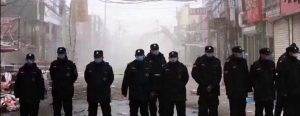VOA published an interview with some guest speakers, who discussed Beijing’s sudden eviction of tens of thousands of its “low-end population” when the weather was very cold. The “Low-end population” refers to people who do work that requires low skills and who do not hold residence status in Beijing. Below is a selection from the guest speaker’s comments.
1) It is hard to accept the term “low-end population” because it grades people into different categories. Of course, in sociology, people are divided into different social classes: the bottom, middle, and upper classes. The Chinese Communist Party claims that the proletariat is the master of China but in reality the five percent who are the elite class in China are the real master. The party follows Social Darwinism, which seeks the end result but not the means. The elite can hurt others for their gain. As a matter of fact, their authority has completely deviated from the rule by law they have been promoting. The Party Secretary of Beijing knows how propaganda works and understands the impact the media has. Therefore it is not that he chose to issue the eviction order but he had no other option. He had to force the action and couldn’t wait. It could be that the party thinks that China’s economy will collapse in the next six to 12 months. If large numbers of people are unemployed and unable to survive, it is obvious that these people could pose a huge threat to their authority. These (low-end) people still have work right now. Even though they were evicted they wouldn’t rebel. If they were unemployed, however, it is very unlikely that they wouldn’t leave even if the authorities used guns to chase them out. This is the reason that the authorities do not want to disclose right now.
2) The real reason is that the highest leader became so powerful that he has lost his judgment. He has been successfully suppressing different voices in the past few years, including social group, rights lawyers or rights activists. He feels that he has invincible power now and that he can do anything. Therefore he used a radical approach in urban management and didn’t realize that he is facing fierce resistance from the international society and his own citizens.
Source: VOA Chinese, December 1, 2017
https://www.voachinese.com/a/voaweishi-20171201-pc-china-migrant-worker/4145303.html


